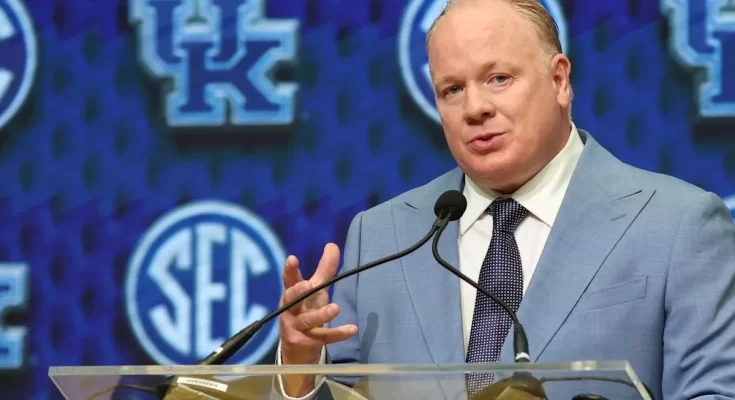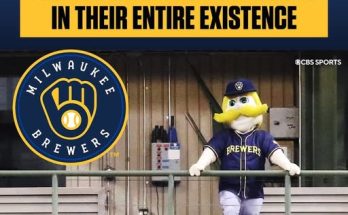Kentucky football turns heads at SEC Media Days sporting electronic backpacks displaying their jersey numbers.
They didn’t just walk into SEC Media Days; they glowed. Kentucky football players strode through the lobby of the event hotel wearing crisp program-issued backpacks with slim LED panels that pulsed to life in Kentucky blue, each screen cycling cleanly into the player’s jersey number. In a sea of logo polos, name placards, broadcast rigs, and the predictable rhythm of media carwash interviews, the Wildcats managed something rare: they made everyone stop, stare, and pull out their phones. Reporters snapped photos. Fans craned over velvet ropes. Social media producers from rival schools leaned in to get a closer look at the tech sewn into the fabric seams. Kentucky didn’t just send representatives; they sent a statement—one that said branding, innovation, and program personality now travel as hand luggage.
At first glance the display was simple: a number, same font styling you’d see on the jersey, bright enough to catch camera light but not so harsh that it washed out on broadcast. But the longer you watched, the more detail emerged. The panel auto-dimmed under bright overheads. The digits animated in a quick pixel-fade when the wearer shifted position, almost like the old-school scoreboard transitions you’d see in Rupp Arena except modernized and miniaturized. Every thirty seconds the display flashed from number to a UK logo and back, and during live photo scrum moments it froze on the number so photogs could get a clean shot. For a day built around interviews, quotes, and storylines, Kentucky found a way to make visual identity the opening line.
Why does that matter? Because SEC Media Days has quietly evolved into a recruiting tool layered under a broadcast event dressed as a press function. Every appearance becomes content. Every piece of content becomes a touchpoint for high school prospects scrolling their feeds. A program that understands this treats the arrival tunnel like a red carpet, not a hallway. The electronic backpacks told recruits three things without a word: Kentucky invests in its athletes; Kentucky thinks creatively about spotlighting individual players; and Kentucky is willing to try something new even when the rest of the league does things the usual way. When you’re competing in a conference where facilities look like spaceports and support staffs rival small companies, small branding edges matter. The portable display put player identity literally on the backs of the athletes, which is where college football’s next generation already lives—on screens, in clips, and in shareable moments.
The gear also functioned as an instant icebreaker in interview rooms. One defensive tackle joked that the backpack meant he’d never lose his luggage carousel-side again. Another player told a cluster of reporters that the equipment staff had loaded custom messages during travel testing, including a “hydrate” reminder that flashed mid-flight. Whether that happened or not in full production mode almost didn’t matter; the anecdote landed because the technology made it plausible. And plausibility is gold in media settings—if something looks innovative, the story grows with it. Now you’ve got conversation starters that keep Kentucky players on camera longer, which means more clips, more quotes, and more chances to control the narrative about the coming season.
There’s a subtler layer tied to NIL visibility. Imagine future iterations where the panel can briefly show an athlete’s personal logo, a charity cause, or a QR code leading to a foundation page or licensed merch drop. Even if SEC regulations or event rules restrict dynamic advertising inside formal interview blocks, the proof of concept is enough to get boosters, collectives, and creative departments thinking. Kentucky has long marketed basketball stars as recognizable brands; extending that infrastructure culturally into football—especially at national visibility moments—signals an institutional willingness to modernize. Recruits who care about building name, image, and likeness portfolios will notice the difference between a school that sets up generic banner walls and one that turns players into mobile digital billboards, respectfully and playfully.
From a logistics standpoint, the backpack design apparently prioritized function over gimmick. The LED matrix was inset in a hardened patch panel with internal wiring secured along the frame, so the pack still held the usual travel items: tablets, playbooks, clothing, recovery gear. Power sat in a rechargeable brick in a sleeve opposite the panel to keep the weight balanced. According to one staffer speaking off-mic in the hallway chatter, battery swaps were hot-swap ready; you could click a new pack in under the interior flap without rewiring the display. That meant Kentucky could keep the numbers lit all morning without tethering players to wall plugs between room rotations. It’s easy for technology stunts to fail in the wild; these didn’t, and that reliability lent authenticity to the whole show.
The visual pop also helped media sorting. SEC Media Days cycles hundreds of credentialed reporters through rotating radio stations, network sets, streaming booths, and print rows. Sometimes a player walks into the wrong line. Sometimes a handler waves frantically from across the room. With jersey numbers blinking on backpacks, a floor producer could id the right athlete instantly: “We need 23 for the SiriusXM hit—you’re up.” It shaved seconds in a chaotic environment. Little efficiencies like that make players less stressed, which often makes interviews better, which again loops back to brand value. Even something as ordinary as shepherding a linebacker from Ballroom A to Studio C becomes smoother when you can read his number from twenty feet away.
Culturally, the move fit the Mark Stoops era ethos: steady, blue-collar development layered with selective flair. Kentucky under Stoops hasn’t tried to out-flash the most flamboyant programs weekly, but it has embraced moments—uniform alternates, social series, creative recruiting mailers—that say, “We see where the sport is going, and we’re not stuck in 1998.” The electronic backpacks live in that lane. They’re not over-the-top; they’re clever, functional, and slightly mischievous, the sort of thing that makes fans proud their school thought of it first. It also plays well regionally. In a league where tradition often sits side by side with arms-race innovation, striking a balance between respect for the helmet and enthusiasm for the highlight reel is a recruiting differentiator.
Players seemed to enjoy the attention. One wide receiver told local radio he hoped the team could program celebratory animations for rivalry week—maybe flashing checkerboard end zone patterns after a win. A lineman wondered aloud whether they could sync the panel to crowd noise decibels in Kroger Field if someone wanted to go full science project. These comments, tossed off in good humor, highlight a deeper truth: when athletes feel they have a hand in the creative expression of the program, buy-in rises. Something as low-stakes as customizing travel gear becomes a soft-culture win; players talk, recruits listen, traditions start. You don’t always engineer culture from top-down speeches; sometimes you grow it from the gear closet outward.
From the media perspective, the backpacks improved content quality. Photos with glowing numbers are more distinguishable in social timelines. Short-form video editors can freeze-frame on the number for lower-third introduction slates without overlay clutter. Graphic teams back at network HQ can match interview clips to roster data faster because the player is visually tagged. Multiply that across dozens of hits during Media Days and the cost-per-visibility ratio begins to look brilliant. Kentucky effectively subsidized national amplification with a one-time creative equipment build. If even one viral clip converts a recruit’s curiosity into a visit, the return dwarfs the production budget.
There’s also an analytics angle waiting to happen. Once you’ve accepted electronics in wearable travel gear, adding passive sensors—RFID location pings inside event venues, load tracking for travel strain, proximity alerts for schedule management—is a short step. While the current iteration focused on display, the wiring harness and power architecture could easily support modular add-ons. Athletic departments already track player wellness via GPS vests in practice; merging utility with branding in public-facing environments may be the next frontier. Imagine Media Days two years from now when programs compare fan engagement metrics tied to live wearable beacons. Kentucky just placed an early marker on that road.
Reactions from rival fan bases ranged from amused to impressed. Social threads lit up with screenshots—“Leave it to Kentucky to bring gameday lights to a press conference,” one commenter wrote—while others speculated about durability, cost, and whether the SEC office would eventually standardize what’s allowed on the interview circuit. Even skeptics conceded the visual worked. In the attention economy, being first rarely hurts; it forces everyone else to respond, and when established powers copy your idea, you’ve already won a round in perception.
When the official interview rotations wrapped and the players filtered into more informal media scrums, the backpacks kept paying dividends. Fans who had staked out autograph zones could identify players even after credentialed media peeled away. The LED numbers gave young fans a way to connect the face in front of them with the player they’d seen on Saturdays without needing a spotter to whisper names. Several impromptu photo ops turned into mini fan engagements: a kid poses with a glowing “7,” the player kneels, the backpack screen reflects in the kid’s glasses, a parent posts the shot, and Kentucky’s brand spreads another ring outward.
By day’s end the talk around the hotel bar wasn’t just which coach delivered the sharpest soundbite or which quarterback dodged the trickiest question; it was also, “Did you see those Kentucky backpacks?” That’s the soft-power win: converting a logistical footnote into a conversation hook that keeps your program in the mix when writers sketch their lead choices on the flight home. Plenty of teams bring elite talent. Fewer bring memorable texture. Texture sticks.
If you strip the whole stunt to its core, it’s about ownership of identity in public spaces. College football rosters are large, travel windows are tight, and media events can blur athletes into interchangeable talking heads. A glowing jersey number re-centers the player: this is 12, this is who you came to hear, this is Kentucky. In an era when players are increasingly entrepreneurial—building brands, hosting podcasts, launching apparel collabs—anything a school does to help them be seen as individuals within a team construct earns goodwill. Goodwill builds trust. Trust helps keep rosters intact through portal seasons that can reshape a depth chart overnight.
Will other programs follow? Almost certainly. Some will go bigger with full-back animations. Others will integrate wearable e-ink nameplates to conserve power. A few may tie displays into live stat feeds during championship week. Kentucky doesn’t need to own the technology forever to benefit; they just needed to show they were willing to lead. And as recruits, fans, and media replay the highlights from SEC Media Days, that flash of blue-lit numerals may linger in mind longer than any canned quote about taking things one week at a time.
In a conference that measures itself in television deals, recruiting rankings, transfer hauls, and trophy case expansions, sometimes the smallest innovation can signal the biggest shift in mindset. Kentucky football walked into the league’s annual stage with something no one else had, and in doing so, they reminded everyone that creativity travels. Whether those backpacks ever see a snap of live action is irrelevant. The mission—make Kentucky impossible to ignore—was accomplished the moment the doors opened and the numbers lit up.



